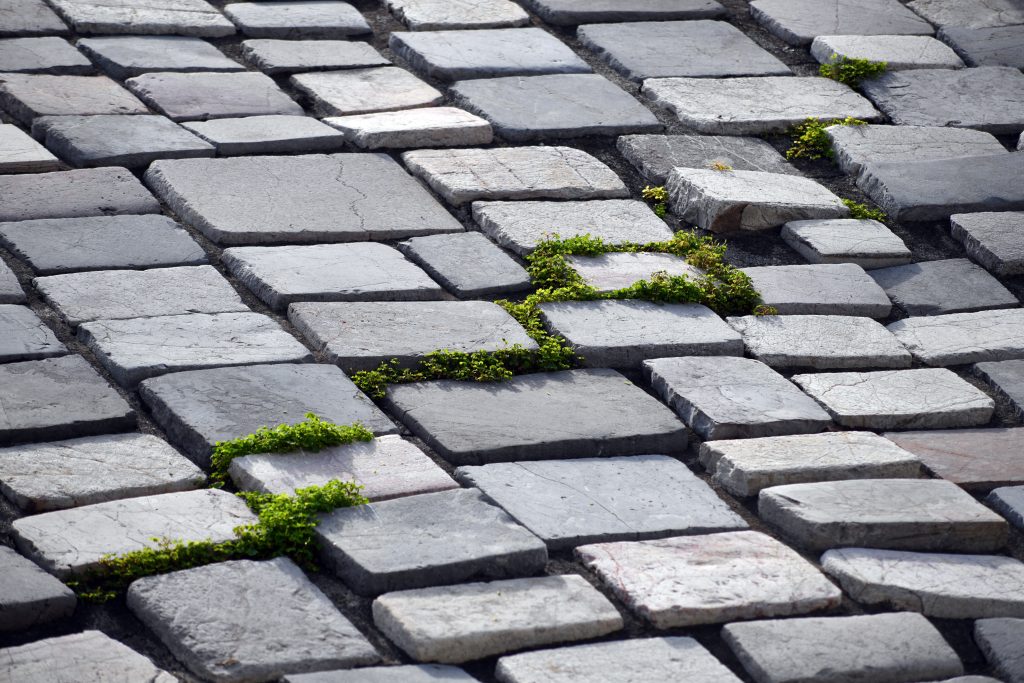Brick pavers can be an excellent addition to your landscaping, providing functional pathways and decorative features. However, you might notice that your brick pavers have begun to sink over time. This can be due to various reasons, but understanding the causes can help you find the most effective solutions.



Poor Compaction
One of the primary reasons brick pavers sink is because of poor soil compaction beneath them. If the soil isn’t compacted well, over time, it can settle and cause the pavers to sink.
Solution: Properly compact the soil before laying the pavers. If they have already sunk, you may need to remove them, re-compact the soil, and then re-lay the pavers.
Erosion
Erosion is a major cause of sinking pavers, compromising the structural integrity of paved surfaces. This can be due to heavy rainfall, which infiltrates gaps between the pavers, washing away the foundational sand or soil. This is particularly problematic in areas prone to heavy rain. Uncontrolled water flow from a natural slope or other sources like a garden hose can also gradually erode the ground beneath the pavers, destabilizing them. The lack of a proper drainage system exacerbates the problem; if water has no designated drainage path, it seeps beneath the pavers, speeding up erosion and, in colder months, causing upheaval and cracking. To summarise, heavy rains, water flow, and insufficient drainage contribute to erosion and sinking pavers. Proper drainage planning and regular maintenance can help prevent this, ensuring paver longevity and aesthetics.
Solution: Ensuring a proper drainage system is in place can prevent erosion. If erosion has already occurred, you must fill and compact the eroded area before replacing the pavers.
Root Growth
The presence of trees or large shrubs can lead to uneven paving. Their root growth can pressure the pavers, making them sink in certain areas.
Solution: Consider removing or transplanting the offending trees or shrubs or cutting back the roots.
Heavy Loads
Landscaping pavers, often used for driveways and garden paths, can sink due to consistent heavyweight, affecting their functionality and appeal. This issue is usually caused by the regular parking or driving of heavy vehicles, which can depress the pavers, leading to an uneven and potentially hazardous surface. Similarly, when left stationary for long periods, heavy garden furniture or accessories can also contribute to this problem. Even regular foot traffic, especially in high-heeled shoes or heavy boots, can worsen the issue. Sunken pavers look unappealing and cause functional problems like water pooling, which erodes the underlying material and deepens the sinking over time. They also pose safety risks, such as tripping, especially in poor lighting. Preventative measures, like periodically moving heavy furniture, limiting vehicle traffic, or using suitable underlay material for better weight distribution, can reduce sinking. Regular upkeep and inspection can help detect and resolve issues early, maintaining your paved surfaces’ look and function.
Solution: Avoid heavy loads on your brick pavers. Consider using a more substantial base material like concrete if this isn’t possible.
Poor Installation
Pavers are popular for landscaping in homes and commercial spaces, providing aesthetic and durable pathways and patios. However, poor installation can lead to sinking pavers, creating issues like aesthetic disruptions and safety hazards. The sinking of pavers can be caused by inaccurate leveling during installation, resulting in uneven surfaces and potential drainage issues. Over time, this creates a disjointed and possibly dangerous pathway. Another cause is inadequate base preparation. The base supports the pavers and associated loads, and if not properly prepared, it can lead to paver displacement and sinking. This issue becomes more prevalent in areas with heavy rain or freezing temperatures, leading to base movement and sinking pavers. Additionally, the use of unsuitable or low-quality materials can also lead to sinking pavers. If not compatible with the installation type or local climate, the choice of pavers, base materials, and fillings can compromise the surface’s longevity and cause sinking. In conclusion, sinking pavers signify incorrect installation, which can be due to faulty leveling, improper base preparation, or unsuitable materials. Therefore, meticulous planning, precise execution, and carefully selecting high-quality materials are paramount for a durable, functional, and pleasing paved surface.
Solution: Hiring a professional for installation is best to ensure it’s done correctly. If the pavers have already sunk, they may need to be removed, the base corrected, and the pavers reinstalled. In conclusion, while sinking brick pavers can be a problem, understanding the causes can help you find the right solutions. For best results, consider hiring a professional to ensure proper installation and maintenance.
